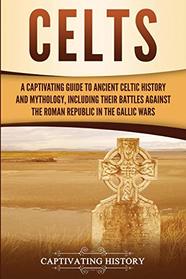It really is unfortunate that the Celts were not interested in writing down their history. From this text, we learn that the Celts were wide-ranging peoples who lived in an incredible number of countries: (places now called) Spain, Portugal, Germany, Italy, Czech Republic, Romania, France, Switzerland, Belgium, Serbia, Ukraine, Bulgaria, Turkey, as well as England, Wales, Ireland, and Scotland. That is some landmass -- to be documented over so much territory without a single word written by the Celts themselves, is amazing.
We learn that the weakness of the Celts is their lack of political unity or structure. They were as likely to fight with each other as they were to band together to fight an enemy. Their strength was their common language and culture. Generally, the expansion of the Romans into Western Europe came at the expense of the Celts. I did not know that the Gallic Wars were essentially Julius Caesar fighting the Celts of (what is now) France.
'Thank you' to the author for including such topics as Celtic daily life, their social structure, Celtic government, Celtic religion (they practiced polytheistic paganism), and Celtic art. Surprisingly, the Celts were an agricultural society that was deeply religious and used raiding as a way to further their way of life.
One fascinating bit of info about the Celts and Stonehenge is that (through carbon dating), Stonehenge does not belong to the Celtic religion. Stonehenge appeared about 1000 years before the Celts came to England.
We learn that the weakness of the Celts is their lack of political unity or structure. They were as likely to fight with each other as they were to band together to fight an enemy. Their strength was their common language and culture. Generally, the expansion of the Romans into Western Europe came at the expense of the Celts. I did not know that the Gallic Wars were essentially Julius Caesar fighting the Celts of (what is now) France.
'Thank you' to the author for including such topics as Celtic daily life, their social structure, Celtic government, Celtic religion (they practiced polytheistic paganism), and Celtic art. Surprisingly, the Celts were an agricultural society that was deeply religious and used raiding as a way to further their way of life.
One fascinating bit of info about the Celts and Stonehenge is that (through carbon dating), Stonehenge does not belong to the Celtic religion. Stonehenge appeared about 1000 years before the Celts came to England.




